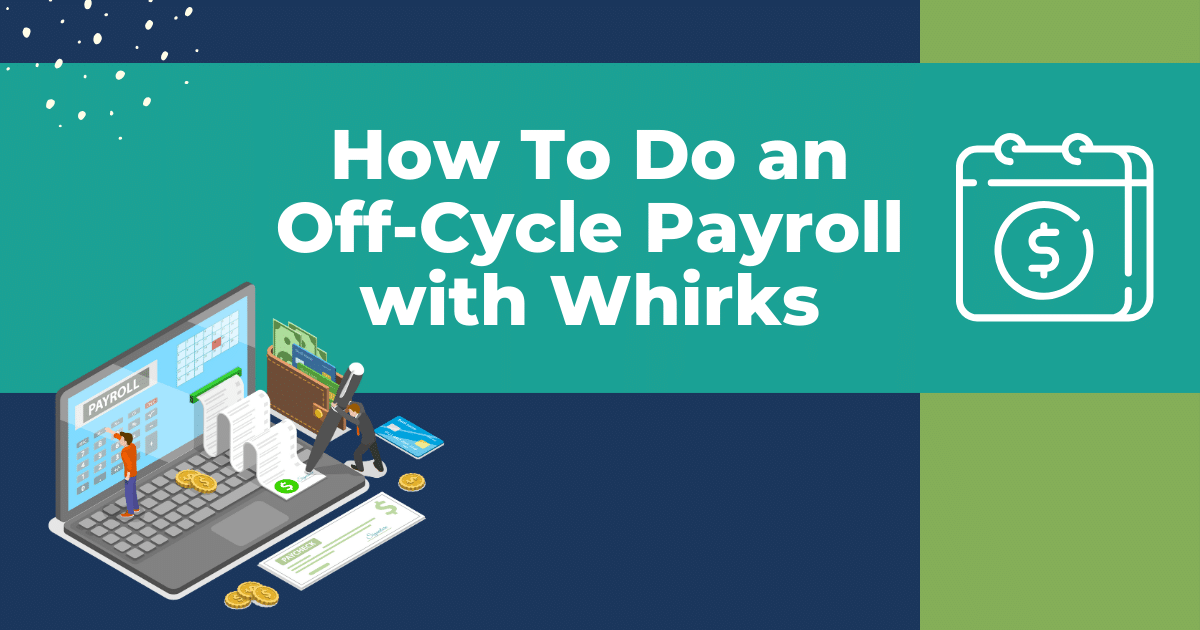How To Do an Off-Cycle Payroll with Whirks
October 19th, 2023 | 3 min. read

Envision a typical workday – your pay date was yesterday, and everything appears to be in order. Then, out of the blue, one of your employees approaches you with a pressing question: “Why wasn’t I paid this time?” With a sense of unease, you log in and realize that you inadvertently omitted their hours. As panic ensues, you hastily reach out to your Whirks Client Success Specialist (CSS). You’ve made an error in an employee’s paycheck, and you're left wondering, “What’s the solution?”
During your conversation with your CSS, they’ll guide you through two potential resolutions: off-cycling payroll or issuing a manual check. In this article, we’ll delve into the ins and outs of off-cycling payroll, shedding light on when it’s most beneficial.
What Is an Off-cycle Payroll Anyway?
Off-cycle payroll refers to the process of employers issuing paychecks to employees outside of their regular pay cycle. While regular payroll cycles follow a set schedule for recurring payments, off-cycle payroll is used selectively to ensure prompt and accurate employee compensation during unforeseen events. Here at Whirks we often refer to these as “special” payrolls. It can be used for unique payment requirements, such as:
- Make a correction or adjustment to a payment that was made on your regular payroll run
- Providing payments in a timely manner to departing employees
- Distributing bonuses or incentives that you want taxed differently from your regular payroll (especially common around the holidays)
- Other exceptional circumstances
An understanding of off-cycle payroll is not only essential for employers but also beneficial for employees. It guarantees that compensation is delivered promptly (as long as the bank cutoff is met) and accurately during unforeseen circumstances. This not only maintains trust and satisfaction among employees but also equips businesses with the means to tackle payroll challenges with efficiency.
Off-cycle Payroll vs Manual Check
When you’re faced with the need to rectify a payroll hiccup or make bonus payments, your CSS will guide you through your options, one of which is the off-cycle payroll. Here’s what an off-cycle payroll allows you to do:
- Direct Deposit Convenience: enables you to deposit funds directly into your employee’s bank account.
- Enhanced Security for Multiple Payments: If you have several employees to compensate, running an off-cycle payroll is more secure than writing a multitude of manual checks. It minimizes the risk associated with physical checks and provides a reliable method of payment.
- No Need for Physical Checks: Off-cycle payroll becomes especially beneficial if you lack the capability to issue physical checks. In this digital age, where remote work is increasingly prevalent, having an alternative payment method is a valuable asset.
It’s important to note that an off-cycle payroll will entail an additional processing fee. In contrast, when opting for manual checks, you won't incur such fees. Your choice between the two methods should consider the specific needs of your situation, as well as the most efficient and cost-effective approach for your business. Your client success specialist can assist you in making the right choice for your unique circumstances.
Okay, So I Want To Do an Off-cycle Payroll- Now What?
Once you’ve determined that an off-cycle payroll is the right solution for your situation, the first step is to inform your CSS. They’ll take the reins and facilitate the setup in isolved. Here’s a step-by-step breakdown of what follows:
- Setting Up the Off-Cycle Payroll: Your CSS will skillfully configure the payroll run in isolved, ensuring that it aligns with your specific needs.
- Data Entry: With the payroll setup complete, you’ll have the flexibility to manually input any missed hours, commissions, or bonuses using the Time Entry Grid or the Individual Time Entry Grid.
- Payroll Processing: Once all the necessary data is accurately entered, it’s time to navigate to the Payroll Processing section. Here, you can review your payroll to confirm that everything appears as it should.
- Reports and Validation: Take a moment to generate essential reports to cross-verify the accuracy of the payroll data. This added step ensures that your records and error-free.
- Final Submission: If everything looks to be in order, confidently hit the “Submit” button. Your off-cycle payroll is now complete!
Manual Checks
The other option your CSS can introduce you to is the manual checks. A manual check is precisely what it sounds like: you personally write out a check and hand it directly to your employee. Subsequently, your CSS manually records this payment within the isolved system. This option is typically the most straightforward when you have only a small number of employees to compensate, and you have the capability to issue physical checks. It’s important to keep in mind that when choosing the manual check option, you need to inform your CSS to ensure they can accurately record the earnings within the isolved platform.
If you’re uncertain about which option is best suited to your specific needs, don’t hesitate to contact your Client Success Specialist. Their goal is to provide you with the support necessary for your business to thrive and succeed. Additionally, Whirks offers weekly office hours for you to get all your business questions answered. You can sign up for those here.
Topics: